- 1 Heliophysics Sciences Division, NASA Goddard Spaceflight Center, Greenbelt, MD, United States
- 2 Goddard Planetary Heliophysics Institute, University of Maryland Baltimore County, Baltimore, MD, United States
- 3 Space Science and Engineering Department, Southwest Research Institute, San Antonio, TX, United States
- 4 Department of Physics and Astronomy, University of Texas at San Antonio, San Antonio, TX, United States
- 5 Laboratory for Atmospheric and Space Physics, University of Colorado Boulder, Boulder, CO, United States
- 6 Physics Department, Catholic University of America, Washington, DC, United States
- 7 Department of Astronomy, University of Maryland College Park, College Park, MD, United States
Magnetic reconnection is a fundamental process in the solar wind-magnetosphere system, driving energy transfer into the magnetosphere and space weather effects. In this study, we use the formula derived in Lockwood et al. (Journal of Geophysical Research: Space Physics, 1992, 97, 14841–14847) to calculate the dayside magnetopause reconnection rate using ion-energy dispersion data from the most modern iteration of the Defense Meteorological Satellite Program (DMSP) and modeling of the dayside southward reconnection system. We study the March 23–24, 2023, geomagnetic storm, where continuous reconnection produced seven consecutive passes of ion-energy dispersion with the DMSP F18 satellite. Our results indicated that in each case, when it is assumed that the dispersion is a temporal (rather than a spatial) structure, the reconnection rates are generally between 0.1 and 2 mV/m, commensurate with other studies. Major uncertainties arise from determining the ion cutoff energy, spacecraft trajectory angle, and injection distance. We compare our methods with an alternative
1 Introduction
Magnetic reconnection is a fundamental process between the Earth’s magnetosphere and solar wind material ejected from the sun. It is the primary method through which solar wind material and associated energy enter the magnetosphere, leading to the most notable magnetospheric phenomena and the domain of near-Earth space weather. The reconnection process is well established to occur for both southward and northward IMF.
The reconnection electric field is the out-of-plane electric field at the point where field lines break and reconnect. A stronger reconnection electric field leads to faster energy release. The global rate of dayside magnetopause is given by the integral of the parallel electric field over the dayside x-line (the magnetic field line corresponding to the intersection of the magnetic separatrix surfaces). In a quasi-steady reconnection scenario, the parallel electric field at a point on the x-line is roughly the same as the perpendicular electric just outside the reconnection diffusion region. This perpendicular electric field is thus often taken as a proxy for the reconnection rate. Accelerated ions streaming away from the reconnection site along newly reconnected field lines (Fuselier et al., 1991; 2000; Trattner et al., 2005a), leave a signature in the cusp region of the magnetosphere. This work will focus on dayside reconnection during southward IMF.
Dispersed ion-energy precipitation in the cusp is the spreading of particles by energy over magnetic latitude due to a mix of convection and varying time-of-flight effects associated with the reconnection that causes higher-energy particles to precipitate at lower magnetic latitudes during southward IMF (Lockwood and Smith, 1989; Basinska et al., 1992; Connor et al., 2012; 2015; Trattner et al., 2015). The precise structure of this dispersion is shaped by the reconnection rate and magnetic and electric field structures of the dayside magnetosphere.
This manuscript builds upon the work of Lockwood and Smith (1992), which derives a formula to calculate the dayside magnetopause reconnection rate from structure within the dispersed ion-energy spectrogram measured somewhere in either the low altitude or high altitude cusp. In that work, the ion spectrogram is characterized as a time series
The reconnection rate calculation applies to a spacecraft traversing the cusp that measures precipitating ion dispersion. One such set of spacecraft is the Defense Meteorological Satellite Program (DMSP) with their Special Sensor J (SSJ) precipitating plasma payload (Redmon et al., 2017). The DMSP orbits vary between satellites but are all sun-synchronous and primarily survey the northern cusp on the dayside post-noon sector. Because DMSP spacecraft have been carrying similar space environment sensors since the 1970s, they provide a powerful historical record of precipitating plasma in the cusp. An advantage of using DMSP over high-altitude missions such as Cluster is that the revisit rate per cusp, defined by the orbital period, is much shorter for DMSP than Cluster (101 min vs. 54 h), leading to more substantial potential for statistical and long-term studies (da Silva et al., 2024).
However, a limitation of the methodology presented in this manuscript as applied to DMSP involves the space-time ambiguity. It is impossible to use one satellite to distinguish whether the change in energy over time is caused by a time-varying process coinciding with the satellite pass (a temporal structure), or spatial variation in continuous particle streams that are not time-varying (a spatial structure). The algorithm presented here assumes that the observed dispersion is a temporal structure, but because each DMSP satellite crosses at different local times, it is impossible to use DMSP to distinguish spatial and temporal structures. Furthermore, with DMSP, the orbits include both east-west and north-south components around the cusp, which, for some events, makes it difficult to distinguish whether the dispersion is over magnetic latitude or longitude. Examples of temporal and spatial structures observed in the cusp and more details on the differences can be found in Trattner et al. (1999), Trattner et al. (2002), Trattner et al. (2005b).
In 2025, the Tandem Reconnection and Cusp Electrodynamics Reconnaissance Satellites (TRACERS) satellites will launch with state-of-the-art instrumentation for measuring plasma and fields in the low altitude cusp. These issues around the space-time ambiguity will be addressed by TRACERS, which includes two satellites spaced 2-min apart in an orbit centered around noon. Among the science objectives of the 1-year TRACERS mission is to determine how the reconnection rate evolves, and hence, computing the reconnection rate from cusp dispersion is essential. In preparation for the TRACERS mission and to apply the method to DMSP data outside the TRACERS mission lifetime, in this work, we study the calculation using data from DMSP, with the assumption that the observed dispersions are temporal in nature, to advance the state of the art. Discoveries from the TRACERS mission, such as when and where temporal versus spatial structures emerge based on IMF, could relieve this issue with DMSP and allow for long-term statistical studies by filtering out possible spatial structures using this knowledge.
In the Data section, we review the modern DMSP SSJ sensor and the related instruments we will use. In the Observations section, we calculate the reconnection rate for seven instances of ion-energy cusp dispersion made with the DMSP F18 satellite in the northern cusp. These occur over seven subsequent passes during the March 23–24, 2023 geomagnetic storm when the IMF
2 Data
In this work, data from three DMSP satellites F16, F17, and F18 is used. Each satellite is in a sun-synchronous orbit with an altitude between 840 and 860 km. The orbits of each satellite are designed to work in unison, and they vary by the longitudinal point of the equatorial crossing. Each satellite carries identical instrumentation. In this work, we utilize data from the SSJ instrument (Special Sensor J) for the results presented in the Observations, Calculation Review, and Calculation Analysis sections. In the later section titled Comparison to
The SSJ instruments collect particles traveling towards Earth with an aperture of
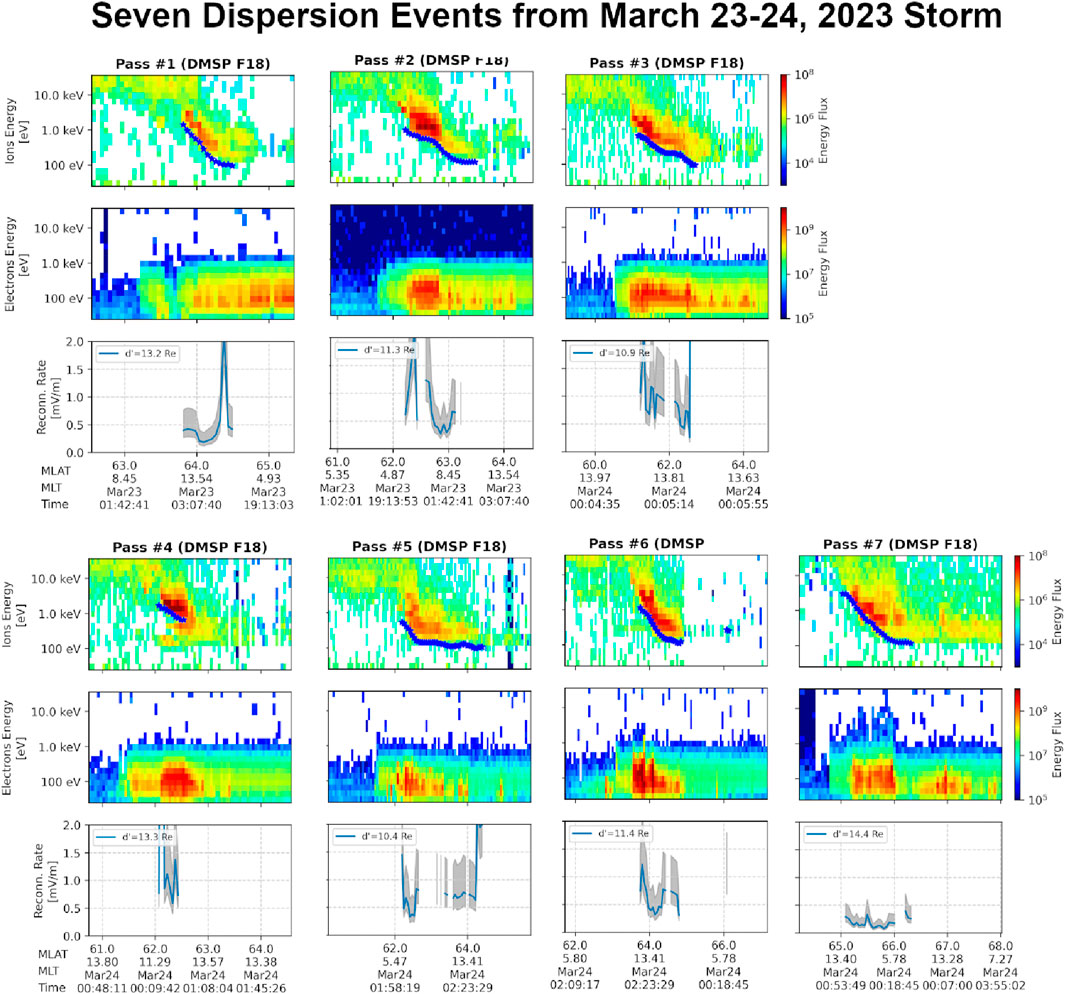
Figure 1. Consecutive ion-energy dispersion events made with DMSP F18 during the March 23–24, 2023 Geomagnetic Storm, with their calculated reconnection rates. Reconnection rates are zoomed to the range of values where they are most certain. Error bars are drawn to with the calculation repeated using
The DMSP SSJ instrument is sensitive to particles in a small range for each channel. This is smaller than the spacing between energy channels, and no particle flux data is measured between these sensitive regions. This constrains the precision that the lower energy cutoff can reasonably measure. Quantifying this uncertainty and propagating through the Lockwood formula shall be considered in the Calculation Analysis section.
Because of the DMSP inclined orbits, most of their dayside time is spent in the northern hemisphere and most of the nightside time in the southern hemisphere (Oliveira and Zesta, 2024). Therefore, for this study, we are restricted to the northern cusp for our analysis of dayside precipitation.
To connect DMSP observations to the upstream solar wind, we use the OMNI dataset at a 1-min cadence (King and Papitashvili, 2020). OMNI is a calculated measurement of the interplanetary magnetic field (IMF), solar wind density, and pressure at Earth’s bow shock derived from L1 measurements of these variables. Specifically, OMNI propagates these measurements from the L1 point to Earth’s bow shock using simple ballistic physics to provide a convenient derived variable for magnetospheric data analysis. OMNI uses data from two spacecraft: the Advanced Composition Explorer (ACE) (Stone et al., 1998) and Wind (Ogilvie and Desch, 1997; Ogilvie et al., 1995).
3 Observations
In Figure 1, we present the ion and electron spectrograms from the DMSP SSJ instrument on F18 for seven consecutive passes of the northern cusp. Each panel is a consecutive pass spaced about 101 min apart, as defined by the orbital period. For each subsequent pass, dispersion is apparent in the ion spectrogram, and an electron burst coincides with the ion dispersion. The electrons are not expected to display dispersion on the same time scale as the ions (da Silva et al., 2022). We note that the peak flux (color bar color) in each dispersion structure is generally between
IMF and SYM-H values during each event can be found in Table 1. It is statistically unlikely that each of these passes was triggered by transient reconnection that, by chance, coincided with the satellite’s cusp traversal. The more likely scenario is that continuous reconnection occurred throughout this period, perhaps with modulations during unobserved times, with the satellite sampling an often present process. Continuous reconnection processes have been established through remote observation of the aurora (Frey et al., 2003) and analysis of cusp dispersion (Trattner et al., 2015). During this storm, we also observed dispersion events from DMSP F16 and F17, similar to those seen in F18. For additional context on the IMF and Dst index during this storm, see Supplementary Appendix Section 1.1, and for the ionospheric potential and open/closed boundaries, see Supplementary Appendix Section 1.2.
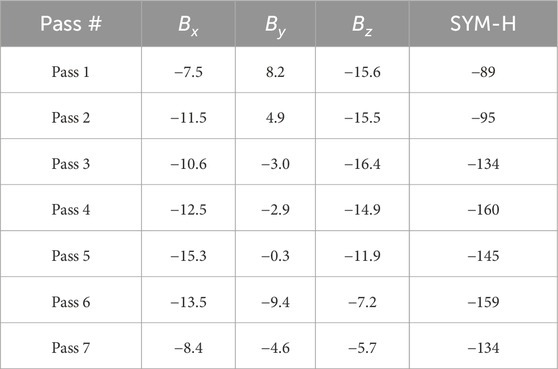
Table 1. OMNI IMF and SYM-H values during each event, in units of nT. IMF values are in GSM coordinates.
The spatial locations of the dispersion events are presented in a polar plot of the northern hemisphere in Figure 2. The precise magnetic local time (MLT) and magnetic latitude (MLAT) of the dispersion structures vary between passes as a function of the IMF (Petrinec et al., 2023) and solar wind dynamic pressure. The ion dispersion occurs in MLAT between
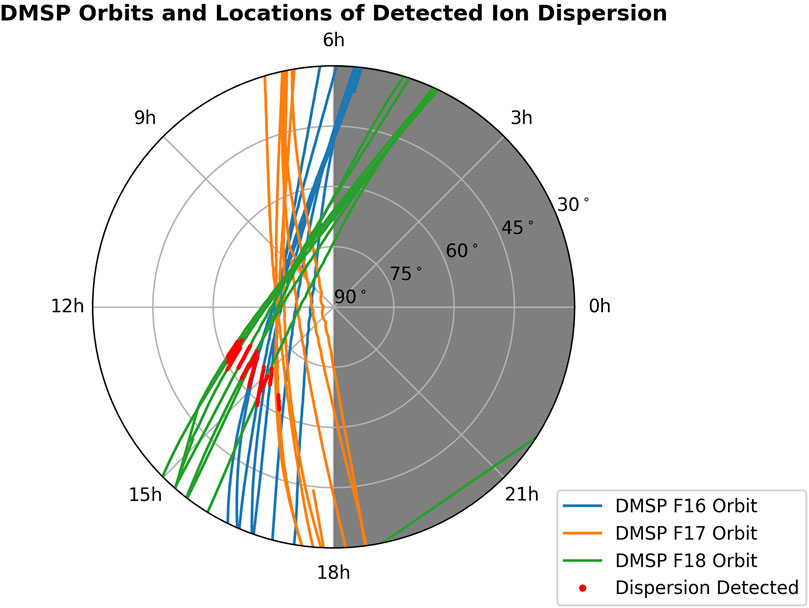
Figure 2. DMSP satellite (F16, F17, and F18) orbit tracks in magnetic coordinates during the event, with red highlights where dispersion events were detected. The cusp can be understood to be around the red detection region.
In the bottom panel of each dispersion event in Figure 1, a calculation of the reconnection rate is shown for multiple values of
Error bars are drawn using the method from Lockwood and Smith (1992). This method, which addresses uncertainty in
We observe from Figure 1 that the stable values are generally within 0.1–2 mV/m range. This range is commensurate values reported in previous work, such as Mozer and Retino (2007), where an average reconnection rate of 1.25 mV/m was calculated from eleven reconnection events using observations from the Magnetospheric Multiscale Mission (MMS) (Burch et al., 2016). It is also similar to (though slightly under) the estimated range of 3.2
4 Calculation review
We will now discuss how the reconnection rate was calculated. The methodology for calculating the reconnection rate was first described in Lockwood and Smith (1992), and is reviewed here. The calculation inherently assumes that the dispersion is a temporal structure (Trattner et al., 2008), caused by the evolution of newly opened field lines.
For a parcel of ions arriving at the spacecraft, the time at which the parcel was injected onto the field line can be estimated as
with
Defining a coordinate system in the low altitude neighborhood of the spacecraft where
where
Using Faraday’s law, the rate at which flux is opened in an infinitesimal segment
where
Magnetopause Reconnection Rate from Ion-Energy Dispersion Equation
5 Calculation analysis
The calculation outlined in Calculation Review requires estimating many variables to assemble a dayside reconnection model. While the variables like
First, we address the FOV limitations of DMSP SSJ (5) before going forward. The FOV spans a
The magnetometer data was compared with the instrument FOV for the two events for which magnetometer data. The pitch angle coverage was computed by calculating the angle between
The ion energy cutoff
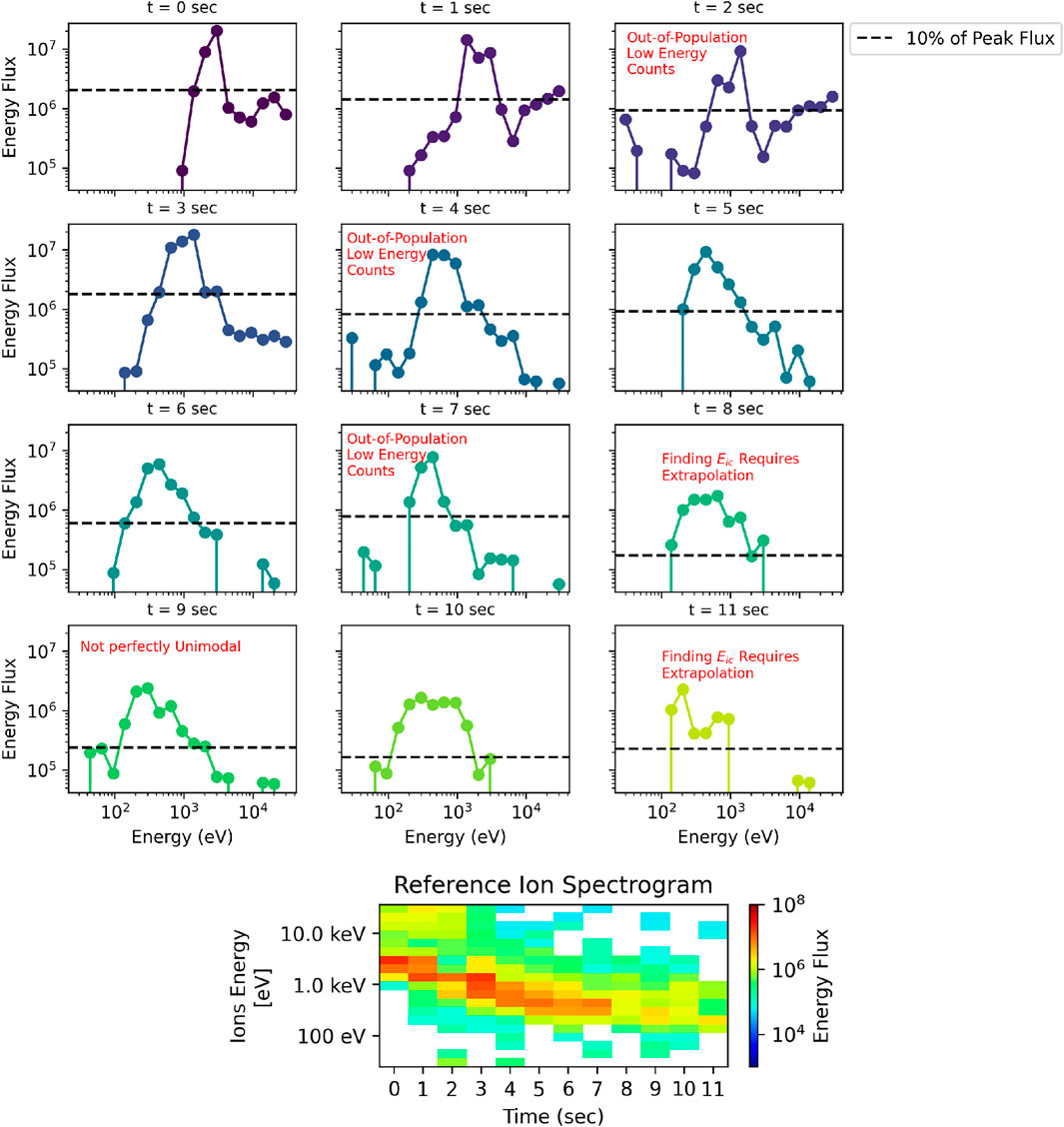
Figure 3. Illustration of a major source of uncertainty in calculating the reconnection rate with DMSP, which is picking the
We note that other work on the cusp has calculated the ion energy cutoff by fitting a Gaussian distribution to the distribution function
Regarding the width scaling between ends of flux tube
where
where
The distance between the injection source with parallel acceleration
The angle between the spacecraft and the direction at which new field lines are opened is denoted by
Such modeling includes the determination of the x-line location, such as through an analysis of the magnetic shear between the magnetosheath and the magnetosphere. A magnetic shear analysis for our events is presented in Figure 4. In this plot, the well-established Maximum Magnetic Shear model (Trattner et al., 2017). Figure 4 plots the magnetic shear across the magnetopause in the colored background, and plots the x-line as a gray line. In this model, the magnetosheath magnetic field is calculated using an analytic model based on upstream measurements made by Wind Kobel and Flückiger (1994), the magnetospheric magnetic field is estimated with the semi-empirical Tsyganenko 1995 model often abbreviated as T96 (Tsyganenko, 1995), and the magnetic shear is the angle between the two.
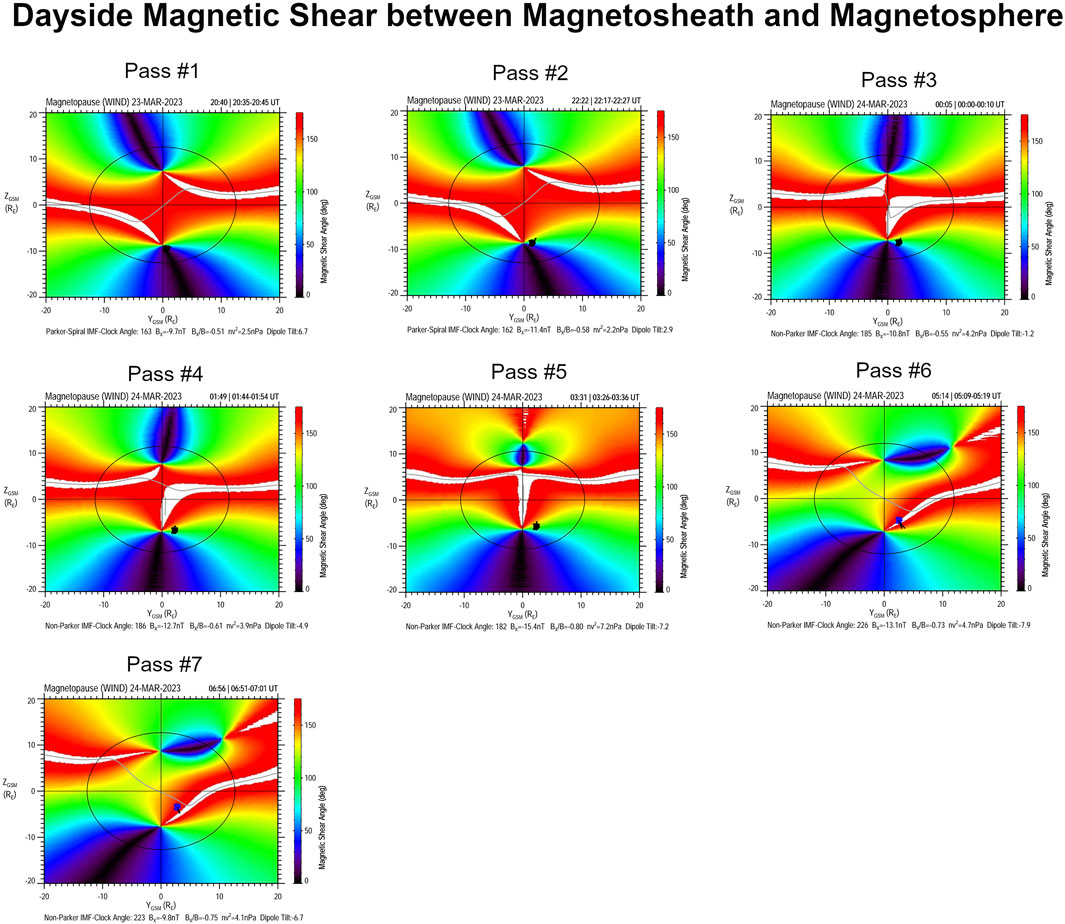
Figure 4. Magnetic Shear between the magnetosheath and magnetospheric magnetic field as calculated using the Maximum Magnetic Shear Model (Trattner et al., 2017). The passes identified in the title of each panel correspond to those labeled in Figure 1.
Each panel is calculated using the closest available output to the corresponding pass. Specifically, we refer to cases represented in passes #6 and#7, where the location of the x-line suggests strong longitudinal field line convection. In these cases, in the absence of ion drift and magnetometer data, considering
To study the effect of
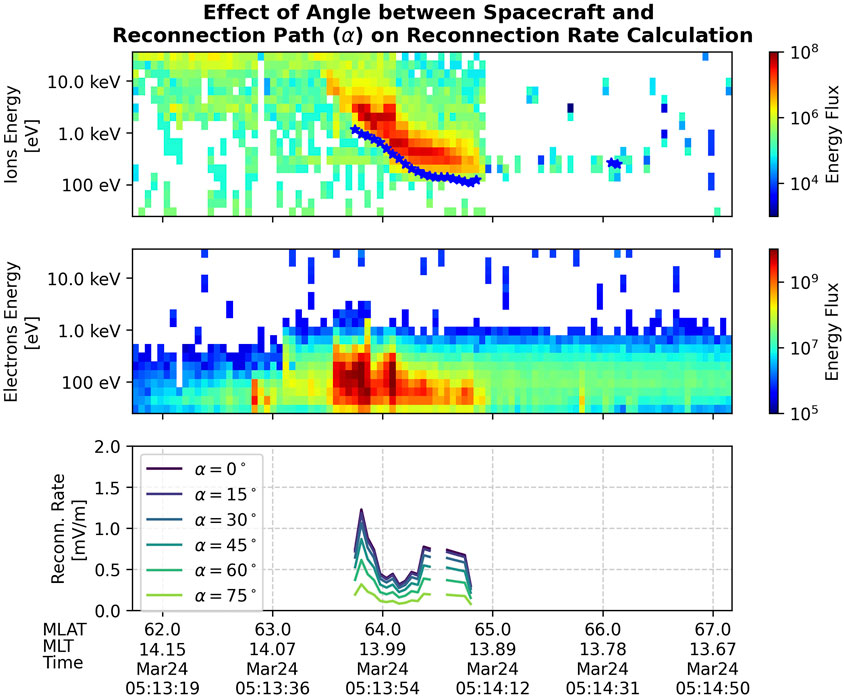
Figure 5. Illustration of the effects of varying
We also note that in Figure 1, the values of
As a point of discussion, we note that the calculation is intrinsically temporally limited overall. A 100 eV field-aligned proton takes 11.5 min to travel 15
6 Comparison to
baseline
In this section, we sanity-check the calculation results from the previous sections using an alternate method. The comparison made in this section will justify the order of magnitude. Still, because of the comparison methodology’s limitations, it cannot justify any more minor time-scale features in the reconnection rate curve.
The method we compare as a baseline utilizes DMSP’s SSM magnetometer and the SSIES IDM ion drift measurements. Using the Ohm’s law approximation, we calculate
Magnetopause Reconnection Rate from
where
In Figure 6, we compare the reconnection rate from the Lockwood method with that of the baseline for passes #2 and #7. In both cases, the reconnection rate curves produced by the
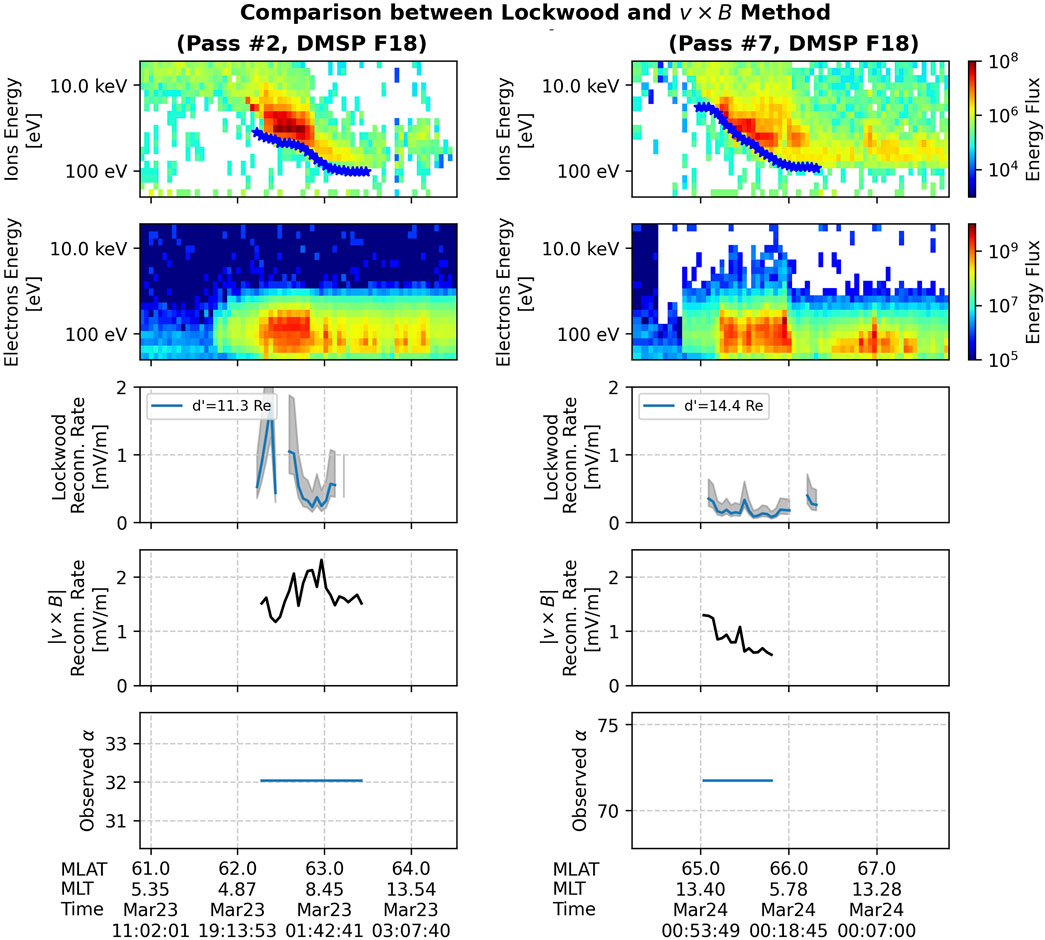
Figure 6. Comparison between the Lockwood Method and the
We also present the observed
The DMSP SSM and SSIES instruments use a coordinate system where
For reference, if
7 Conclusion
In this work, we applied the Lockwood and Smith (1992) method to calculate the dayside reconnection rate using dispersion ion-energy cusp signatures observed by the DMSP satellites. By analyzing dispersion present in seven consecutive passes during a time of continuous southward IMF reconnection in the March 23–24, 2024, geomagnetic storm, we demonstrated the feasibility of applying DMSP SSJ data to study storm-time reconnection rates and found a largely consistent reconnection rate during the main phase of the March 23–24, 2024 geomagnetic storm.
We note that a limitation of using DMSP for the calculation described here revolves around the space-time ambiguity. The Lockwood method assumes a temporal structure causes the dispersion, but it is impossible to distinguish between temporal and spatial structures with DMSP. This work is presented in the hope that results from improved instrumentation on the TRACERS mission and ground radar will provide enhanced understanding on the role and rate of temporal versus cusp structures. For instance, information such as how rare/common one is compared to the other would change the landscape of applying the methodology. If it is concluded that temporal structures appear in orbit at a rate significantly more frequently than spatial structures, then for certain space weather applications the benefits of applying the methodology may outweigh the cost of accepting some misapplications.
In future work, this methodology could be extended to other spacecraft or combined with ground-based radar. Ground-based radars, such as the Super Dual Auroral Radar Network (SuperDARN) (Greenwald et al., 1995; Chisham et al., 2007), have previously been used to measure the ionospheric electric field and calculate the dayside reconnection voltage (de La Beaujardiere et al., 1991; Hubert et al., 2006). Other spacecraft in higher orbits, such as Cluster, also traverse the high altitude cusp (beyond 2
Our results indicate the calculated reconnection rates with DMSP during this storm were generally between 0.1 and 2 mV/m, when very uncertain (usually higher) values are excluded. This range of values is similar to previous estimations of the reconnection rates during geomagnetic storms obtained using in-situ MMS observations (Mozer and Retino, 2007; Genestreti et al., 2018). In this manuscript, we extended the previous discussion in the literature on uncertainty sources for the Lockwood method, such as the determination of the ion cutoff energy
This work highlights the potential for long-term statistical studies of the reconnection using the extensive multi-decade DMSP dataset, should we come to a point where the assumption of temporal structure can be justified on a case to case basis. Future instrumentation, such as that which will fly with the TRACERS mission, will provide an opportunity to further test the Lockwood method. An avenue for future work during the TRACERS era is the study of other storms with more pronounced changes in the reconnection rate during the main phase.
Data availability statement
The original contributions presented in the study in the form of code and associated data are publicly available. They can be found on Zenodo at https://doi.org/10.5281/zenodo.15660989
Author contributions
DS: Software, Conceptualization, Methodology, Formal Analysis, Writing – original draft, Writing – review and editing, Investigation. LC: Methodology, Conceptualization, Writing – review and editing, Writing – original draft. SF: Writing – review and editing, Methodology. KT: Methodology, Writing – review and editing. BB: Methodology, Writing – review and editing. ID: Writing – review and editing, Methodology. NB: Methodology, Data curation, Writing – review and editing. JD: Writing – review and editing.
Funding
The author(s) declare that financial support was received for the research and/or publication of this article. This work was supported by NASA.
Conflict of interest
The authors declare that the research was conducted in the absence of any commercial or financial relationships that could be construed as a potential conflict of interest.
The author(s) declared that they were an editorial board member of Frontiers, at the time of submission. This had no impact on the peer review process and the final decision.
Correction note
A correction has been made to this article. Details can be found at: 10.3389/fspas.2025.1691031.
Generative AI statement
The author(s) declare that no Generative AI was used in the creation of this manuscript.
Publisher’s note
All claims expressed in this article are solely those of the authors and do not necessarily represent those of their affiliated organizations, or those of the publisher, the editors and the reviewers. Any product that may be evaluated in this article, or claim that may be made by its manufacturer, is not guaranteed or endorsed by the publisher.
Supplementary material
The Supplementary Material for this article can be foundonline at: https://www.frontiersin.org/articles/10.3389/fspas.2025.1607611/full#supplementary-material
References
Alken, P., Maus, S., Lühr, H., Redmon, R., Rich, F., Bowman, B., et al. (2014). Geomagnetic main field modeling with DMSP. J. Geophys. Res. Space Phys. 119, 4010–4025. doi:10.1002/2013ja019754
Balogh, A., Dunlop, M., Cowley, S., Southwood, D., Thomlinson, J., Glassmeier, K., et al. (1997). The Cluster magnetic field investigation. Space Sci. Rev. 79, 65–91. doi:10.1007/978-94-011-5666-0_3
Basinska, E. M., Burke, W. J., Maynard, N. C., Hughes, W., Winningham, J., and Hanson, W. (1992). Small-scale electrodynamics of the cusp with northward interplanetary magnetic field. J. Geophys. Res. Space Phys. 97, 6369–6379. doi:10.1029/91ja03023
Burch, J., Moore, T., Torbert, R., and Giles, B.-h. (2016). Magnetospheric multiscale overview and science objectives. Space Sci. Rev. 199, 5–21. doi:10.1007/s11214-015-0164-9
Chisham, G., Lester, M., Milan, S., Freeman, M., Bristow, W., Grocott, A., et al. (2007). A decade of the super dual auroral radar network (superdarn): scientific achievements, new techniques and future directions. Surv. Geophys. 28, 33–109. doi:10.1007/s10712-007-9017-8
Connor, H., Raeder, J., Sibeck, D., and Trattner, K. (2015). Relation between cusp ion structures and dayside reconnection for four IMF clock angles: OpenGGCM-LTPT results. J. Geophys. Res. Space Phys. 120, 4890–4906. doi:10.1002/2015ja021156
Connor, H., Raeder, J., and Trattner, K. (2012). Dynamic modeling of cusp ion structures. J. Geophys. Res. Space Phys. 117. doi:10.1029/2011ja017203
da Silva, D., Chen, L., Fuselier, S., Petrinec, S., Trattner, K., Cucho-Padin, G., et al. (2024). Statistical analysis of overlapping double ion energy dispersion events in the northern cusp. Front. Astronomy Space Sci. 10, 1228475. doi:10.3389/fspas.2023.1228475
da Silva, D., Chen, L., Fuselier, S., Wang, S., Elkington, S., Dorelli, J., et al. (2022). Automatic identification and new observations of ion energy dispersion events in the cusp ionosphere. J. Geophys. Res. Space Phys. 127, e2021JA029637. doi:10.1029/2021ja029637
de La Beaujardiere, O., Lyons, L., and Friis-Christensen, E. (1991). Sondrestrom radar measurements of the reconnection electric field. J. Geophys. Res. Space Phys. 96, 13907–13912. doi:10.1029/91ja01174
Egedal, J., Daughton, W., and Le, A. (2012). Large-scale electron acceleration by parallel electric fields during magnetic reconnection. Nat. Phys. 8, 321–324. doi:10.1038/nphys2249
Frey, H., Phan, T., Fuselier, S., and Mende, S. (2003). Continuous magnetic reconnection at Earth’s magnetopause. Nature 426, 533–537. doi:10.1038/nature02084
Fuselier, S., Klumpar, D., and Shelley, E. (1991). Ion reflection and transmission during reconnection at the Earth’s subsolar magnetopause. Geophys. Res. Lett. 18, 139–142. doi:10.1029/90gl02676
Fuselier, S., Petrinec, S., and Trattner, K. (2000). Stability of the high-latitude reconnection site for steady northward IMF. Geophys. Res. Lett. 27, 473–476. doi:10.1029/1999gl003706
Genestreti, K. J., Nakamura, T., Nakamura, R., Denton, R. E., Torbert, R. B., Burch, J. L., et al. (2018). How accurately can we measure the reconnection rate em for the mms diffusion region event of 11 july 2017? J. Geophys. Res. Space Phys. 123, 9130–9149. doi:10.1029/2018ja025711
Greenwald, R., Baker, K., Dudeney, J., Pinnock, M., Jones, T., Thomas, E., et al. (1995). Darn/superdarn: a global view of the dynamics of high-latitude convection. Space Sci. Rev. 71, 761–796. doi:10.1007/bf00751350
Hubert, B., Milan, S., Grocott, A., Blockx, C., Cowley, S., and Gérard, J.-C. (2006). Dayside and nightside reconnection rates inferred from image fuv and super dual auroral radar network data. J. Geophys. Res. Space Phys. 111. doi:10.1029/2005ja011140
Kihn, E., Redmon, R., Ridley, A., and Hairston, M. (2006). A statistical comparison of the AMIE derived and DMSP-SSIES observed high-latitude ionospheric electric field. J. Geophys. Res. Space Phys. 111. doi:10.1029/2005ja011310
Kletzing, C. (2019). The Tandem reconnection and cusp electrodynamics reconnaissance satellites (TRACERS) mission. AGU Fall Meet. Abstr. 2019, A41U–2687.
Kobel, E., and Flückiger, E. (1994). A model of the steady state magnetic field in the magnetosheath. J. Geophys. Res. Space Phys. 99, 23617–23622. doi:10.1029/94ja01778
Lockwood, M., and Smith, M. (1992). The variation of reconnection rate at the dayside magnetopause and cusp ion precipitation. J. Geophys. Res. Space Phys. 97, 14841–14847. doi:10.1029/92ja01261
Lockwood, M., and Smith, M. F. (1989). Low-altitude signatures of the cusp and flux transfer events. Geophys. Res. Lett. 16, 879–882. doi:10.1029/gl016i008p00879
Mozer, F., and Retino, A. (2007). Quantitative estimates of magnetic field reconnection properties from electric and magnetic field measurements. J. Geophys. Res. Space Phys. 112. doi:10.1029/2007ja012406
Ogilvie, K., Chornay, D., Fritzenreiter, R., Hunsaker, F., Keller, J., Lobell, J., et al. (1995). SWE, a comprehensive plasma instrument for the Wind spacecraft. Space Sci. Rev. 71, 55–77. doi:10.1007/bf00751326
Ogilvie, K., and Desch, M. (1997). The wind spacecraft and its early scientific results. Adv. Space Res. 20, 559–568. doi:10.1016/s0273-1177(97)00439-0
Oliveira, D. M., and Zesta, E. (2024). Inter-hemispheric energy input into the ionosphere-thermosphere system during magnetic storms: what we can and cannot learn from DMSP observations. J. Geophys. Res. Space Phys. 129, e2024JA032486. doi:10.1029/2024ja032486
Petrinec, S., Kletzing, C., Bounds, S., Fuselier, S., Trattner, K., and Sawyer, R. (2023). TRICE-2 rocket observations in the low-altitude cusp: boundaries and comparisons with models. J. Geophys. Res. Space Phys. 128, e2022JA030952. doi:10.1029/2022ja030952
Redmon, R. J., Denig, W. F., Kilcommons, L. M., and Knipp, D. J. (2017). New DMSP database of precipitating auroral electrons and ions. J. Geophys. Res. Space Phys. 122, 9056–9067. doi:10.1002/2016ja023339
Stone, E. C., Frandsen, A., Mewaldt, R., Christian, E., Margolies, D., Ormes, J., et al. (1998). The advanced composition explorer. Space Sci. Rev. 86, 1–22. doi:10.1007/978-94-011-4762-0_1
Torbert, R., Russell, C., Magnes, W., Ergun, R., Lindqvist, P.-A., LeContel, O., et al. (2016). The FIELDS instrument suite on MMS: scientific objectives, measurements, and data products. Space Sci. Rev. 199, 105–135. doi:10.1007/978-94-024-0861-4_5
Trattner, K., Burch, J., Ergun, R., Eriksson, S., Fuselier, S., Giles, B., et al. (2017). The MMS dayside magnetic reconnection locations during phase 1 and their relation to the predictions of the maximum magnetic shear model. J. Geophys. Res. Space Phys. 122, 11–991. doi:10.1002/2017ja024488
Trattner, K., Fuselier, S., Peterson, W., Boehm, M., Klumpar, D., Carlson, C., et al. (2002). Temporal versus spatial interpretation of cusp ion structures observed by two spacecraft. J. Geophys. Res. Space Phys. 107, SMP–9. doi:10.1029/2001ja000181
Trattner, K., Fuselier, S., Peterson, W., Sauvaud, J.-A., Stenuit, H., Dubouloz, N., et al. (1999). On spatial and temporal structures in the cusp. J. Geophys. Res. Space Phys. 104, 28411–28421. doi:10.1029/1999ja900419
Trattner, K., Fuselier, S., Petrinec, S., Yeoman, T., Mouikis, C., Kucharek, H., et al. (2005a). Reconnection sites of spatial cusp structures. J. Geophys. Res. Space Phys. 110. doi:10.1029/2004ja010722
Trattner, K., Fuselier, S., Petrinec, S., Yeoman, T. K., Escoubet, C., and Reme, H. (2008). The reconnection site of temporal cusp structures. J. Geophys. Res. Space Phys. 113. doi:10.1029/2007ja012776
Trattner, K., Fuselier, S., Yeoman, T., Carlson, C., Peterson, W., Korth, A., et al. (2005b). Spatial and temporal cusp structures observed by multiple spacecraft and ground based observations. Surv. Geophys. 26, 281–305. doi:10.1007/1-4020-3605-1_12
Trattner, K., Onsager, T., Petrinec, S., and Fuselier, S. (2015). Distinguishing between pulsed and continuous reconnection at the dayside magnetopause. J. Geophys. Res. Space Phys. 120, 1684–1696. doi:10.1002/2014ja020713
Keywords: reconnection rate, magnetospheric cusp, ion energy dispersion, magnetic reconnection, dayside magnetosphere
Citation: da Silva DE, Chen LJ, Fuselier SA, Trattner KJ, Burkholder BL, DesJardin IM, Buzulukova N and Dorelli JC (2025) Calculation of the dayside reconnection rate from cusp ion-energy dispersion. Front. Astron. Space Sci. 12:1607611. doi: 10.3389/fspas.2025.1607611
Received: 07 April 2025; Accepted: 02 June 2025;
Published: 07 July 2025; Corrected: 13 October 2025.
Edited by:
Ankush Bhaskar, Vikram Sarabhai Space Centre, IndiaReviewed by:
Tieyan Wang, Rutherford Appleton Laboratory, United KingdomHomayon Aryan, University of California, Los Angeles, United States
Copyright © 2025 da Silva, Chen, Fuselier, Trattner, Burkholder, DesJardin, Buzulukova and Dorelli. This is an open-access article distributed under the terms of the Creative Commons Attribution License (CC BY). The use, distribution or reproduction in other forums is permitted, provided the original author(s) and the copyright owner(s) are credited and that the original publication in this journal is cited, in accordance with accepted academic practice. No use, distribution or reproduction is permitted which does not comply with these terms.
*Correspondence: D. E. da Silva, ZGFuaWVsLmUuZGFzaWx2YUBuYXNhLmdvdg==
 D. E. da Silva
D. E. da Silva L. J. Chen1
L. J. Chen1 S. A. Fuselier
S. A. Fuselier B. L. Burkholder
B. L. Burkholder J. C. Dorelli
J. C. Dorelli